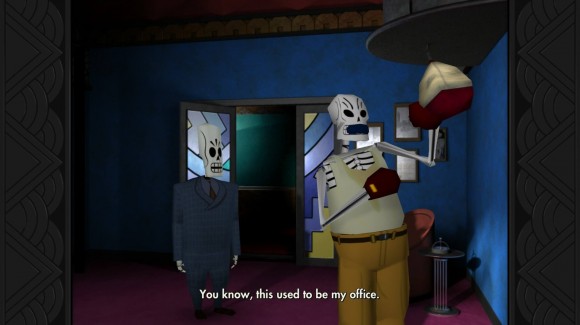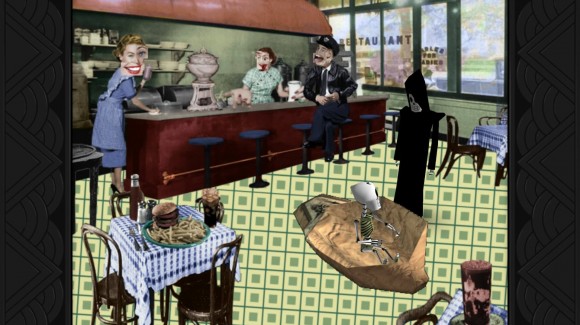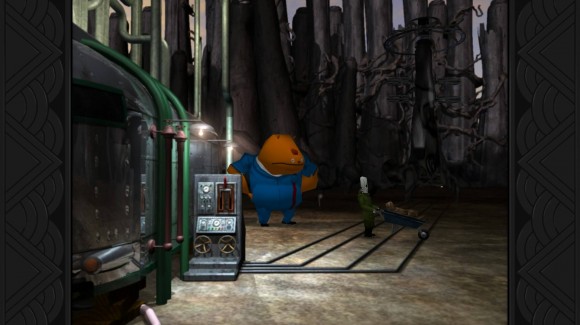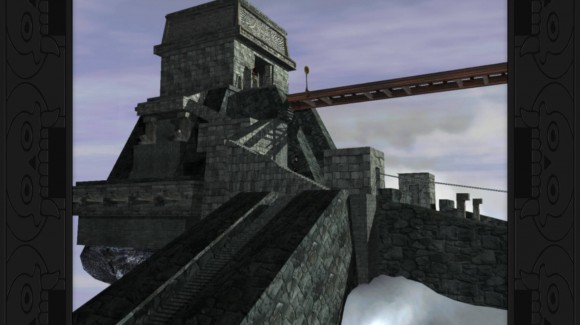If there is a game responsible for cementing Tim Schafer’s reputation as a one of the most unique minds in the industry, it surely is the surreal Grim Fandango. The game has built up something of a mystique over time as a game mostly existing in the distant mists of warm childhood memories. This mystique is aided by the fact that as time went on technology made Grim Fandango harder and harder to play in modern machines, to the point where before the remake was announced it had become something of a lost masterpiece that few modern games could hope to match. A younger Lucio was a big fan of the title (and Lucas Arts adventure games in general). As the remake was announced I was excited but also curious. Often the things one loves as a youth do not always stand up to the scrutiny that comes with adulthood, and even great games often age badly. I am happy to report that aside from some “old school” annoyances, Grim Fandango still holds up remarkably well.
Grim Fandango tells the story of Manuel “Manny” Calavera, a grim reaper and travel agent to the newly immigrated souls he reaps. In true Schafer fashion, this is framed like a sales job where Manny must sell these souls a travel packages to their after life. Good souls get train tickets to get there in a matter of minutes, while the worst of the worst must undertake a dangerous four year journey on foot. Manny is paying off a debt for some transgression in life with the commission from these packages but has, as of late, hit a bit of a slump. His clients are just not good, and his rival seems to get all the people who are qualified for anything good. He has been given until the next sales report to make a sale or he will be fired, and so Manny decides to take drastic measures to bag himself a premium client. This sets off a series of events that will have Manny embarking on an adventure that will take him across the land of the dead, unravel conspiracies, and perhaps even help Manny’s lost soul find redemption.
I have explained before that a point and click adventure game is essentially an exercise in following a logical path laid out by the designers. This is by and large what determines difficulties in this type of game. Since it was released during the heyday of the point and click adventure game, Grim Fandango is definitely on the hard end of the scale. It can be daunting at first, but the game does get easier as you progress and you get into the particular wavelength the game requires. Still, it can become frustrating in some areas as the game leaves clues for you around its massive levels, but you are never sure if you are looking at a clue, or just a detail. The difficulty is not insurmountable. Usually paying attention to the surroundings will provide you with the information you need to proceed through the game. Even so, the game can be frustrating at times, and like any old school adventure, it provides no assistance.
The game provides numerous reasons to persevere. The story takes place in a wonderful, unique world that blends the mundane and the fantastic in the way that we have come to expect in Double Fine games. It is perhaps one of the best examples of how to do this blend correctly in gaming, as the world is supernatural, but still follows consistent rules. The plot mostly has a playful feel, but the superb writing is strong enough that it easily adapts to changes in tone, from dramatic to even romantic in some instances. This is backed up by amazing voice acting, particularly when considering the period in which it was recorded. The dialogue and stories have held up after all these years. I feel that I perhaps enjoyed the game in a different way this time around, and maybe even enjoyed it more than when I was younger. There are actions and plot points that, as an adult, I have more perspective to understand than I did when I was teenager playing this game. If the mark of a great work is that you get something different out if you visit it at different points in your life, then Grim Fandango definitely is a great work.
The most evident upgrade in the remastered version are the graphics. Not only have some of the more pixely edges been smoothed out, but the character models have brand new HD textures that look great. The pre-rendered backgrounds, while still looking somewhat dated, have been cleaned up to look smoother. There are some nice lightning effects added to the game, particularly evident is the dynamic lighting on Manny’s cigarette. Unfortunately, these changes look their best when presented at its native 4:3 aspect ratio. The game lets you change to the widescreen format, but I found that it looks better to just stick to the original resolution. Aside from the graphical enhancements, the game also features an orchestral soundtrack, developer commentary, and a wealth of concept art to look at.
Perhaps the most drastic change is the addition of a new control scheme that allows for analog support. This makes controlling Manny much easier and smoother than it was in the original game in most circumstances. There were some instances where the controls just did not seem to work as intended, and where I had to revert to the original controls. It also has not fixed every instance of bad controls, for example, the Bone Wagon is still hard and confusing to control. Still, in general the controls are much better than in the classic version. Of course, for purists the option to use the old “tank” controls is still in the game, but after trying the new ones, I would find it very hard to go back. Auto save is missing from the game altogether. Take special note of that as forgetting can cause you to lose hours of work if you forget to save. The game also crashed on one occasion for me. I had thankfully saved a few minutes before, but my previous save had been something in the neighborhood of 5 hours before. I don’t think adding auto save would have been such a big deal, or that it would have detracted from the game so much to justify its exclusion.
After all these years, Grim Fandango is a game that still holds up. The improvements, especially when it comes to the controls, will give returning fans an easier reintroduction. The great parts of the game are still all there, the great plot, the wonderful world building, the jokes, the excellent voice acting. And of course if you are feeling particularly nostalgic, you can play the game as it was in its original release. New comers will find a game that could be a bit frustrating, but in the end worth it. I had the advantage of remembering a lot of the puzzles, but lets be honest, if you have never played the game before you can just get one of the many, many guides that have been around for almost two decades. You no longer have to call the Lucas Arts help line, or hope you knew another player that owns it and isn’t a liar. So whether a returning player, or a new comer looking to experience a classic, I give it a hearty recommendation.










